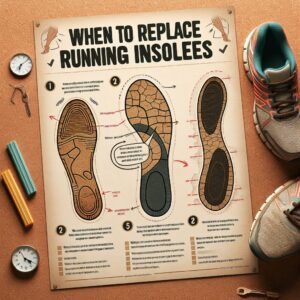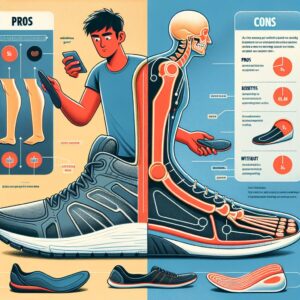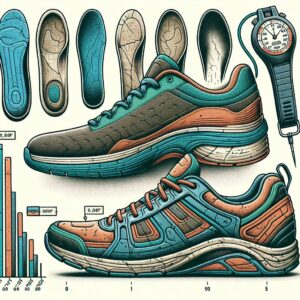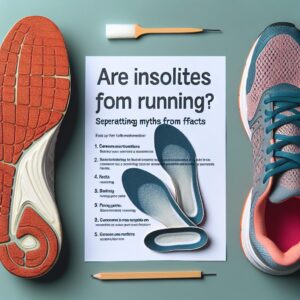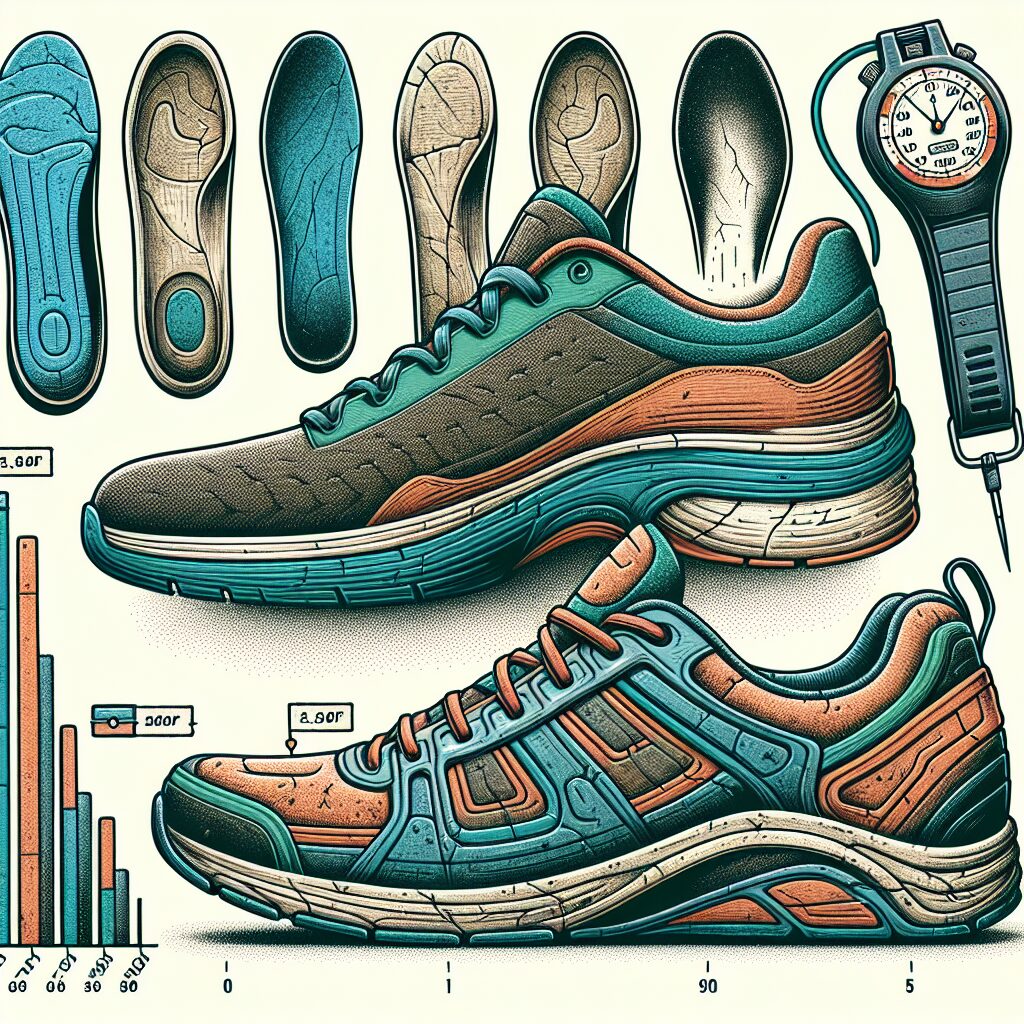
Maximizing Mileage: Do Insoles Really Extend Running Shoe Life
-
Table of Contents
Whether you need extra support in your running shoes largely depends on your individual foot structure, gait, and any specific conditions or issues you may have. Neutral running shoes do not contain a built-in support system and are usually lighter, offering focused cushioning in the heel area. On the other hand, stability running shoes feature a built-in support system, a thicker midsole foam, and are generally heavier. Wearing the shoe that provides the correct support for your feet is crucial for both comfort and injury prevention.
Additionally, even runners with neutral arches can benefit from wearing arch support running shoes, as they may notice improved shock absorption and balance during their runs. It’s clear that the need for extra support is individual and should be determined based on personal comfort, running mechanics, and any recommendations from foot and ankle specialists.
.
Exploring the Impact of Insoles on Running Shoe Durability

Maximizing mileage is a common goal for many runners, and one method that has been suggested to achieve this is the use of insoles. The question that arises, however, is whether insoles truly extend the life of running shoes. This article aims to explore the impact of insoles on running shoe durability.
Running shoes, like any other type of footwear, are subject to wear and tear. The constant pounding on the pavement, the friction from the foot’s movement, and the weight of the runner all contribute to the gradual breakdown of the shoe’s materials. Over time, this can lead to a decrease in the shoe’s cushioning and support, which can, in turn, increase the risk of injury.
Insoles are often touted as a solution to this problem. These inserts, which are placed inside the shoe, are designed to provide additional cushioning and support. They can be made from a variety of materials, including foam, gel, and plastic, and are available in a range of shapes and sizes to fit different types of feet and shoes.
The theory behind the use of insoles is that they can help to absorb some of the shock that would otherwise be absorbed by the shoe. This, in turn, can help to reduce the wear and tear on the shoe’s materials, potentially extending its lifespan. In addition, insoles can also help to distribute the runner’s weight more evenly across the foot, which can further reduce the strain on the shoe.
However, while this theory may sound plausible, the reality is a bit more complex. The effectiveness of insoles in extending the life of running shoes can depend on a variety of factors, including the type of insole, the type of shoe, and the individual runner’s biomechanics.
For example, some studies have found that certain types of insoles can indeed help to reduce the wear and tear on running shoes. These insoles are typically made from durable materials and are designed to provide a high level of cushioning and support. On the other hand, other studies have found that some insoles can actually increase the wear and tear on shoes, particularly if they are not properly fitted or if they are made from materials that compress easily.
Similarly, the type of shoe can also play a role. Some shoes are designed to be more durable than others, and the use of insoles may have a greater impact on the lifespan of these shoes.
Finally, the individual runner’s biomechanics can also influence the effectiveness of insoles. For example, runners with certain types of foot strike patterns may benefit more from the use of insoles than others.
In conclusion, while insoles can potentially help to extend the life of running shoes, their effectiveness can vary depending on a variety of factors. Therefore, runners who are considering the use of insoles should consult with a professional, such as a podiatrist or a running shoe specialist, to ensure that they choose the right insoles for their needs.
Maximizing Mileage: The Role of Insoles in Extending Running Shoe Life
Maximizing mileage is a common goal for many runners, and one of the ways to achieve this is by extending the life of their running shoes. A popular method that has been suggested to achieve this is the use of insoles. However, the question remains: do insoles really extend the life of running shoes?
Insoles, also known as footbeds or inner soles, are removable components placed inside the shoe to provide additional comfort, support, and cushioning. They are designed to reduce foot pain and discomfort, enhance performance, and prevent injuries. However, their role in extending the life of running shoes is a topic that has been subject to much debate.
The primary function of insoles is to provide a cushioning effect, reducing the impact on the feet when running. This cushioning effect can help to reduce the wear and tear on the shoe’s midsole, which is the part of the shoe that absorbs the most impact during running. By reducing the impact on the midsole, insoles can potentially extend the life of the shoe.
Moreover, insoles can also help to distribute the weight of the runner more evenly across the shoe. This can prevent certain parts of the shoe from wearing out faster than others, which can also contribute to extending the shoe’s lifespan.
However, it’s important to note that the effectiveness of insoles in extending shoe life can vary greatly depending on several factors. These include the quality of the insoles, the running style of the individual, and the type of running shoes used. High-quality insoles that are well-suited to the individual’s foot shape and running style are likely to be more effective in extending shoe life than low-quality insoles or insoles that are not a good fit for the individual.
Furthermore, while insoles can help to extend the life of running shoes, they are not a magic solution that can make shoes last indefinitely. Running shoes are subject to a lot of wear and tear, and even with the use of insoles, they will eventually need to be replaced. The general recommendation is to replace running shoes every 300-500 miles, depending on the individual’s running style, body weight, and the surface on which they run.
In conclusion, while insoles can potentially extend the life of running shoes by reducing impact on the midsole and distributing weight more evenly, their effectiveness can vary greatly depending on the quality of the insoles and the individual’s running style. Therefore, while insoles can be a useful tool in maximizing mileage, they should be used in conjunction with other shoe care practices, such as regular cleaning and proper storage, to truly extend the life of running shoes. And, of course, even with the best care, all running shoes will eventually need to be replaced to ensure optimal performance and prevent injuries.
The Truth about Insoles: Do They Really Prolong the Life of Your Running Shoes?
Maximizing mileage is a common goal for many runners, and one of the ways to achieve this is by ensuring that their running shoes last as long as possible. The longevity of running shoes is a critical factor that can significantly impact a runner’s performance and comfort. Consequently, many runners have turned to insoles as a potential solution to extend the life of their running shoes. However, the question remains: do insoles really prolong the life of running shoes?
Insoles, also known as footbeds or inner soles, are removable components placed inside the shoe to provide additional comfort, support, and fit. They come in various types, including custom orthotics, cushioned insoles, and arch support insoles, each designed to cater to different needs. The primary function of insoles is to provide a cushioning effect that reduces the impact on the feet when running. This cushioning effect is believed to reduce the wear and tear on the shoe, thereby potentially extending its lifespan.
However, the effectiveness of insoles in prolonging the life of running shoes is a topic of debate among experts. Some argue that insoles can indeed extend the life of running shoes. They posit that insoles can absorb some of the shock that would otherwise be absorbed by the shoe, reducing the wear and tear on the shoe’s materials. This, in turn, can potentially extend the shoe’s lifespan.
Moreover, insoles can also help maintain the shoe’s structure. Over time, the constant pressure from running can cause the shoe’s interior to deform. By providing additional support, insoles can help maintain the shoe’s shape, preventing premature wear and tear.
On the other hand, some experts argue that insoles do not necessarily prolong the life of running shoes. They contend that while insoles can provide additional comfort and support, they do not significantly reduce the wear and tear on the shoe’s materials. The shoe’s outsole, which is the part that comes into direct contact with the ground, still bears the brunt of the impact when running. Therefore, even with insoles, the outsole will still wear out over time, necessitating a shoe replacement.
Furthermore, the use of insoles can sometimes lead to a false sense of shoe longevity. Runners may feel that their shoes are still in good condition because the insoles provide additional comfort, even when the shoes are already worn out. This can potentially lead to injuries as worn-out shoes do not provide adequate support and protection.
In conclusion, the effectiveness of insoles in extending the life of running shoes is not definitive. While they can provide additional comfort and support, their impact on shoe longevity is not as significant as some might believe. Therefore, runners should not solely rely on insoles to extend their running shoes’ life. Regular inspection of the shoes for signs of wear and tear, proper shoe maintenance, and timely replacement are still the best ways to ensure the longevity of running shoes. After all, the primary purpose of insoles is to enhance comfort and fit, not necessarily to prolong the life of the shoes.After careful analysis, it can be concluded that insoles do contribute to extending the life of running shoes by providing additional cushioning and reducing wear and tear. However, they are not the sole factor in maximizing mileage. Proper care, usage, and shoe quality also play significant roles.
